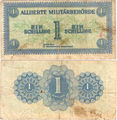A currency is a standardization of money in any form, in use or circulation as a medium of exchange, for example banknotes and coins. A more general definition is that a currency is a system of money in common use within a specific environment over time, especially for people in a nation state. Under this definition, the British Pound Sterling (£), euros (€), Japanese yen (¥), and U.S. dollars (US$)) are examples of (government-issued) fiat currencies. Currencies may act as stores of value and be traded between nations in foreign exchange markets, which determine the relative values of the different currencies. Currencies in this sense are either chosen by users or decreed by governments, and each type has limited boundaries of acceptance; i.e., legal tender laws may require a particular unit of account for payments to government agencies.

The yen is the official currency of Japan. It is the third-most traded currency in the foreign exchange market, after the United States dollar (US$) and the euro. It is also widely used as a third reserve currency after the US dollar and the euro.
The Hong Kong dollar is the official currency of the Hong Kong Special Administrative Region. It is subdivided into 100 cents or 1000 mils. The Hong Kong Monetary Authority is the monetary authority of Hong Kong and the Hong Kong dollar.

The Reichsmark was the currency of Germany from 1924 until 20 June 1948 in West Germany, where it was replaced with the Deutsche Mark, and until 23 June 1948 in East Germany, where it was replaced by the East German mark. The Reichsmark was subdivided into 100 Reichspfennigs. The Mark is an ancient Germanic weight measure, traditionally a half pound, later used for several coins; whereas Reich, comes from the official name for the German state from 1871 to 1945, Deutsches Reich.
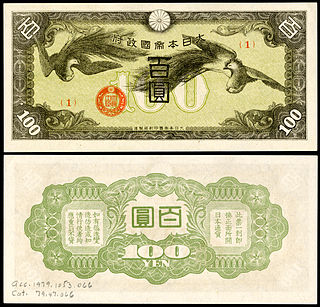
Japanese military currency was money issued to the soldiers of the Imperial Japanese Armed Forces as a salary. The military yen reached its peak during the Pacific War period, when the Japanese government excessively issued it to all of its occupied territories. In Hong Kong, the military yen was forced upon the local population as the sole official currency of the territory. Since the military yen was not backed by gold, and did not have a specific place of issuance, the military yen could not be exchanged for the Japanese yen. Forcing local populations to use the military yen officially was one of the ways the Japanese government could dominate the local economies.

The history of Chinese currency spans more than 3000 years. Currency of some type has been used in China since the Neolithic age which can be traced back to between 3000 and 4500 years ago. Cowry shells are believed to have been the earliest form of currency used in Central China, and were used during the Neolithic period.
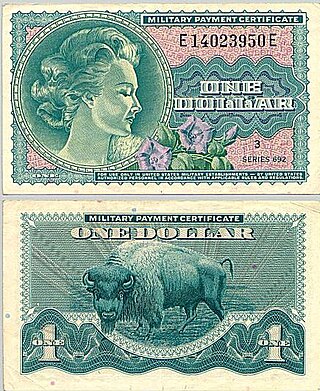
Military payment certificates, or MPC, were a form of currency used to pay U.S. military personnel in certain foreign countries. They were used in one area or another from a few months after the end of World War II until a few months after the end of U.S. participation in the Vietnam War – from 1946 until 1973. MPC utilized layers of line lithography to create colorful banknotes that could be produced cheaply. Fifteen series of MPCs were created. However, only 13 series were issued. The remaining two were largely destroyed, although some examples remain. Among the 13 released series a total of 94 notes are recognized.
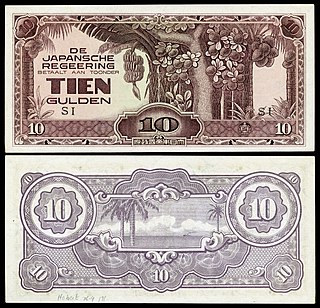
The Netherlands Indies gulden, later the Netherlands Indies roepiah, was the currency issued by the Japanese occupiers in the Dutch East Indies between 1942 and 1945. It was subdivided into 100 sen and replaced the gulden at par.
The pound was one of several issues of Japanese invasion money used during World War II. One pound was subdivided into 20 shillings. Consisting of only four denominations, the Oceanian pound was the shortest set issued. Only notes for £1, 10/–, 1/– and 1/2/– were issued.

The Japanese government-issued dollar was a form of currency issued for use within the Imperial Japan-occupied territories of Singapore, Malaya, North Borneo, Sarawak and Brunei between 1942 and 1945. The currency was also referred to informally as banana money, named as such because of the motifs of banana trees on 10 dollar banknotes. The Japanese dollar was in widespread use within the occupied territories where the previous currency became scarce. The currency were referred to as "dollars" and "cents" like its predecessors, the Straits dollar, Malayan dollar, Sarawak dollar and British North Borneo dollar.
The won was the first South Korean currency and was in use from August 15, 1945, to February 15, 1953.

Emergency circulating notes were currency printed by the Philippine Commonwealth Government in exile during World War II. These "guerrilla pesos" were printed by local government units and banks using crude inks and materials. Due to the inferior quality of these bills, they were easily mutilated.

Korean currency dates back as far as the Goryeo dynasty (918–1392) when the first coins were minted. The coins, cast in both bronze and iron, were called tongbo and jungbo. Additionally, silver vases called ŭnbyŏng were widely used and circulated as a currency among the aristocracy of Goryeo.
The British Armed Forces issued their own banknotes between 1946 and 1972.

Japanese invasion money, officially known as Southern Development Bank Notes, was currency issued by the Japanese Military Authority, as a replacement for local currency after the conquest of colonies and other states in World War II.
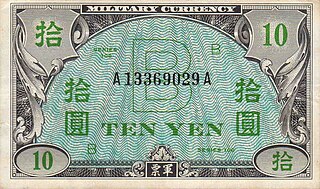
B yen was a colloquial term used to refer to a form of military scrip used in post-war US-Occupied Okinawa from April 15, 1946, to September 1958. Officially, it was called B type military scrip.

The AM-lira was the currency issued in Italy by Allied Military Government for Occupied Territories (AMGOT) after the Allied invasion of Sicily in 1943. 100 AM-lire were worth 1 US dollar.

The Japanese government-issued rupee in Burma was a Japanese invasion money issued by the Japanese Military Authority, as a replacement for local currency during the Japanese occupation of Burma in the Second World War.
A yen was a colloquial term used to refer to a form of military scrip used in post-war US-Occupied Japan, Korea, and Okinawa from September 7, 1945, to July 21, 1948. They are notable for being the first "Military Payment Certificates" given after World War II had ended.
Japanese military currency (日本軍用手票) is the name given to money used by the Japanese armed forces for the purchase of supplies in occupied territories. It was mainly issued in denominations of yen, and subsidiary currency of sen with the exception of the first Sino-Japanese War series. This particular article covers pre-Shōwa era currency issued from 1894 to 1918 in three different periods. During this time Japan was militarily involved in the First Sino-Japanese War, Russo-Japanese War, and events during World War I such as the Siberian intervention. The military currency issued during these events circulated in Japanese Korea, the Republic of China (Manchuria), and the Russian State. All of the notes issued share a similar design which resembles government issued civilian currency which circulated in Japan from 1872 to 1899. Japanese military currency was exchangeable at the given time for both silver and gold bullion. Most of these events were not long term which impacted the amount of surviving currency in different ways. It was also routine after each event for officials to exchange the military currency issued for bullion or other forms of payment such as banknotes. Unredeemed notes were thus either held by the public as commemorates or eventually lost in the decades that followed. Those that remain today are collected and traded depending on the condition and surviving rate of the series. The lower demonization notes are easier overall to obtain than those valued above one yen.

